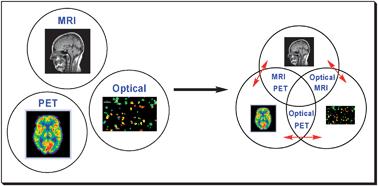Molecular or personalised medicine is the future of patient management and healthcare, and molecular imaging plays a key role towards this goal. However, amongst molecular imaging techniques, no single modality is perfect and sufficient to gain all the necessary information. For instance, optical fluorescence imaging is difficult to quantify—especially in tissue more than a few millimetres in depth within a subject; magnetic resonance imaging (MRI) has superb resolution but low sensitivity and positron emission tomography (PET) has very high sensitivity but poor resolution. The combination of multiple molecular imaging techniques can therefore offer synergistic advantages over any modality alone. However, the problem cannot be solved by simply adding two different classes of imaging probes together, unless they happen to have identical pharmacodynamic properties. Therefore, multi-modal contrast agents or imaging probes have been developed to solve this problem. Despite the great wealth of information that such probes can provide, their development is far from trivial and represents an important challenge to synthetic chemists. In this feature article, we provide an overview of recent findings in the synthesis, evaluation and application of dual-modality molecular imaging probes.

You have access to this article
 Please wait while we load your content...
Something went wrong. Try again?
Please wait while we load your content...
Something went wrong. Try again?


 Please wait while we load your content...
Please wait while we load your content...